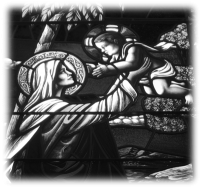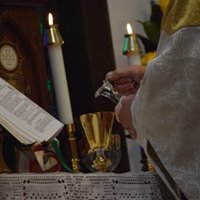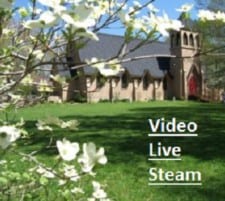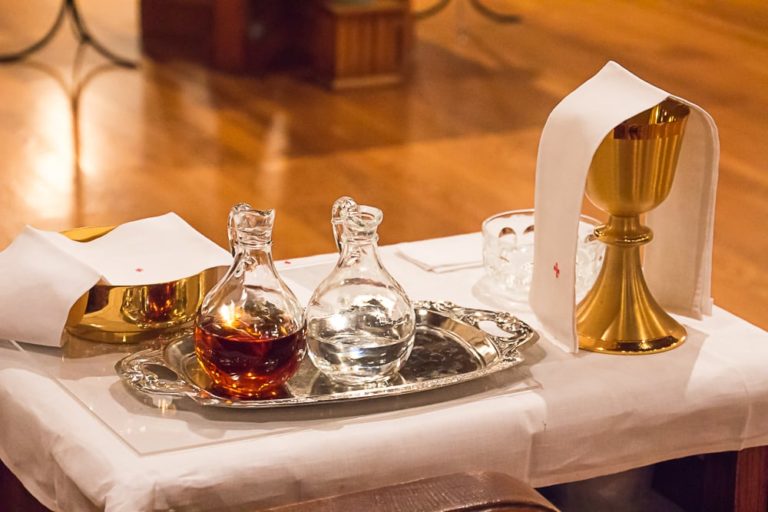Deeper Dive 1 into the Blessed Virgin Mary

OBSERVATIONS ON NEW TESTAMENT ILLUSIONS, CONTEMPORARY OBJECTIONS, AND COMMON BELIEFS/PRACTICES SURROUNDING THE BLESSED VIRGIN MARY
The Rev’d. Allen Fisher
On Viewing the Blessed Virgin Rightly
For a time, Evangelical Protestants, even some post-Vatican II Roman Catholics, have downplayed the role of Mary and shied away from giving her any place in personal spiritual practices (at least in public). Many cite the Bible for their reasons of doing so, although many today are being drawn to Mary precisely because of the Bible. Others will downplay Mary in a spirit of ecumenism in order to be able to get along with the majority of other professed believers, but again believers of today hunger for the fullness of the faith as opposed to the Cliff’s Notes version of Systematic Theology. So, this guide is to introduce how Mary is a part of that fuller faith and to highlight how the generations of the past couple of decades have truncated the faith to such a degree that the Queen-Mother of the inaugurated King of Heaven is treated more like an old arch-nemesis than the new Arch of the Covenant bearing the Presence of her LORD in the world.
Common Objections
We do not discard doctrinal truth simply because we do not understand it or because some other parts of the Church have misunderstood it. If that were the case doctrines of how the salvation provided by Jesus works in the life of the believer would be a moot point. Too often the Scriptures simply tells us what something is or does (“This is my body” Lk.22:19;”Baptism saves you” 1Pet.3:21; cf.Mrk.16:16 “Behold your mother” Jhn.19:27; etc.) without explaining how it is or how it does it. Sadly, the Church universal (i.e. catholic) does not have a great batting average when it comes to explaining how these things work out.
Some will say that since Mary is given so little attention in the Scriptures, we ought to focus on the things spoken of more often, however, those making this argument have grown so unaccustomed with the Bible’s language, especially in the Old Testament, that they miss all the symbolism these few New Testament Scriptures short-handedly tap into to show Mary’s uniqueness in the economy of God. As the New Testament material was written, there is a sense in which the understanding of Mary’s role develops from almost an afterthought in Paul (Gal.4:4 around AD 55), a scandal in Matthew (Matt.1-2 around AD 60), and an oppositional character in Mark (3:20-35; 6:3 around 61AD), to the highly sophisticated and exalted representative in the writings of Luke (Lk.1-2; Act 1:14 around 67AD), John (Jhn.2 & 19 around AD 80), and the seer of Revelation (Rev.12 around 89AD). Taken together, we see that the New Testament Writers paint a picture that, even with these few scant strokes, the observer can begin to see Mary as the perpetual virgin who serves as the new Eve, the new Ark, the Queen-Mother of the King, and spiritual mother of all disciples of Christ. More details on this can be found below, but just with these few biblical titles, why wouldn’t Mary be seen as central to Biblical faith?
Some, though, still see these truths as possible detractors from Jesus’ own exalted position, and continue to insist that any exaltation of Mary, even if done so in these ways, ought to be restrained. However, if glorifying Jesus is our goal it would seem that part of doing so would involve honoring those whom He wants to see honored. We ought to exalt anyone to the position He has exalted them to. For instance, Jesus sees John Baptist as elevated among all the prophets (cf.Matt.11:11; LK.7:28), and it is Scripture itself, that tells us how all of God’s people will call Mary “blessed.” So, she whom Christ has exalted and has given her life over to the will of God ought to be honored as such – not dismissed (cf.Phil.2:29-30).
Others will say Mary is simply an ordinary woman, deserving no more attention than any other of the redeemed of the Lord, yet it is her redeemed “ordinariness” which demands greater attention. C.S. Lewis, who never quite overcame his own suspicions of the Blessed Virgin, wrote of all ordinary believers in his Weight of Glory: “Remember that the dullest and most uninteresting person you talk to may one day be a creature which, if you saw it now, you would be strongly tempted to worship, or else a horror and a corruption such as you now meet, if at all, only in a nightmare… There are no ordinary people. You have never talked to a mere mortal. Nations, cultures, arts, civilization—these are mortal, and their life is to ours as the life of a gnat. But it is immortals whom we joke with, work with, marry, snub, and exploit—immortal horrors or everlasting splendors.” The fact stands that in our Scriptures we find the Blessed Virgin already portrayed as one “full of grace” and just because we find out that some people have indeed in the past been tempted to worship her in her glorified state does not mean that we should be led to reject her out of hand but instead we ought to seek her aid and example for us to be so likewise transformed.
A Biblical Approach
How then ought we approach Mary? The answer lies in very Bible people use to downplay the role of Mary. We approach her as the New Eve whose offspring crushes the head of the serpent and whose faithful obedience to the will of God reverses the effects of the first Eve’s disobedience (as portrayed in the Gospel of John). We approach her as the New Ark and God-Bearer (Greek: theotokos) whose role is to bring God’s Presence to His people (as portrayed in the Gospel of Luke and The Revelation). We approach her as the Queen-Mother (Hebrew: gebiyrah) to the inaugurated, heavenly King who intercedes on behalf of the subjects of His kingdom (as portrayed in The Revelation).
New Eve – New Mother of Mankind
In the Gospel of John, Mary is linked to the first “woman” of the Garden of Eden: Eve (see Gen.2; 3:15; Jhn.2:1-12; 19:25). In these two accounts of John, Mary is addressed unexpectedly as “woman” and both of these occurrences are focused around Jesus’ hour when He is to crush the works of the Devil (cf.12:31-33):
| Genesis Acct (Gen.2; 3:15) | John Acct (Jhn.2:1-2; 19:25) |
| Eve addressed as “woman” | Mary is addressed as “woman” |
| Eve invites Adam to commit the first sin | Mary invites Jesus to perform the first sign |
| Eve stands beside Adam at the fall | Mary stands beside Jesus at the Cross |
| Eve is told her offspring will conquer the works of the serpent | Mary’s offspring conquers the serpent in His hour. |
Then, like Eve, following the ordeal with the serpent Mary is named the Mother of all who would come to live through Her Son (see Gen.3:20 and 19:26-27).
New Ark – Bearer of God
While Eve is a familiar image for most believers to grasp, many will find the idea of Mary as the new ark of covenant a bit more perplexing. Nevertheless, she is presented as such, and this should not be too much of a surprise realizing that the Gospel is much more about the restoration of all things that have been lost than getting a bunch of people to heaven who really don’t want that kind of lifestyle.
The primary thing to recall and know about the ark is that thematically throughout the Old Testament it is the chariot throne of Yahweh. It was the place where God dwelt and ruled among His people (cf.Exod.25) on His throne of law, wisdom, and life (the tablets of the Law, the budding branch of the almond tree, and the manna from heaven were inside it). There the glory cloud of the LORD would descend and overshadow the mercy seat so uniquely that it could be said that where the ark was there God was found (cf.Ps.132:8).
One of the greatest days was when this ark was brought to Jerusalem by King David, and it is the chronology of this event which Luke uses to help people realize the central role of Mary in the salvation story (see Brant Pitre’s chart below). However, the ark’s residence in Jerusalem was not permanent. When God’s people refused to live by God’s will and reign, God left and the ark was lost. Once the ark was lost from Solomon’s temple, the LORD’s glorious presence did not return to any of the subsequent temples built in its place (see Josephus, Histories 5.9).
For this reason, all the way up to Jesus’ day, God’s faithful people looked for the ark’s and its overshadowing Glory Cloud to return (cf.2Macc.2:4-8). So, when we start the Gospel of Luke, the first thing we see is the Ark’s return in the person of Mary (comp.Exod.40:35 LXX and Lk.1:35). Brant Pitre shows this conveniently in his Jesus and the Jewish Roots of Mary:
| The Ark of the Covenant | The Virgin Mary |
| The glory of the Lord and the cloud cover the Tabernacle (containing the Ark) and “overshadow” (episkiaz) them (Exodus 40:34–35, cf. v. 3). | The Holy Spirit comes upon Mary and the power of the Most High “overshadows” (episkiaz) her (Luke 1:35). |
| David “arose and went” to the hill country of Judah to bring up “the ark of God” (2 Samuel 6:2). | Mary “arose and went” into the hill country of Judah to visit Elizabeth (Luke 1:39). |
| David admits his unworthiness to receive the Ark by exclaiming: “How can the ark of the LORD come to me?” (2 Samuel 6:9) | Elizabeth admits her unworthiness to receive Mary by exclaiming: “And why is this granted to me, that the mother of my Lord should come to me?” (Luke 1:43) |
| David “leaped” before the Ark as it was brought in “with shouting” (2 Sam. 6:15–16) | John “leaped” in Elizabeth’s womb at the sound of Mary’s voice and Elizabeth cried “with a loud shout.” (Luke 1:41–42) |
| The Ark remained in the hill country, in the house of Obed-Edom, “three months.” (2 Samuel 6:11) | Mary remained in the hill country, in Elizabeth’s house, “three months.” (Luke 1:56) |
This close connection between Mary and the ark is then picked up once again in Revelation (vv.11:19-12:2, remember that the chapter breaks have been added to the original). In this section of Revelation, both the ark and the woman are shown “appearing” to be in the heavenly temple.
New Queen-Mother – Assisting Kingdom Life
The final office we see the Virgin Mary serving in is that of the Queen Mother whom we see serving in the monarchy started by David. Matthew and Luke put a lot of effort in putting Jesus’ birth in the line of David (just think of Matthew 1:1: “The book of the genealogy of Jesus Christ, the son of David, the son of Abraham.”), and at the Annunciation when the angel spoke to Mary he said that her child would inherit the throne of His father David (Lk.1:30-33), which means Mary would become the new Queen-Mother. This position, now overlooked, and even unheard of by many Christians, became prevalent in those parts of the Old Testament that tell us about the successors of King David (e.g. 1Kng.15:1-2,13; 2Chron.15:16; Jer.13:18; 29:2). When we read through this part of Israel’s history we find that this position was so important that the names of the Queen Mothers were recorded with the names of the Kings they served alongside, not the names of the King’s wife (See the Royal Mothers in 1Kng.14:21; 15:1-2, 9-10; 2Kng.8:25-26; 12:1; 14:1-2; 15:1-2, 32-33; 18:1-2; 21:1,19; 22:1; 23:31,36; 24:7-8,18).
The clearest picture of what this position entailed and how it worked out in day to day affairs is in 1Kings 2:12-20. We see there how the Queen Mother (at that time Bathsheba) reigned at the right hand of the king interceding on behalf of the subjects of the King (at that time Solomon, who when he was born and recognized as the legitimate heir to David’s throne, Yahweh called him His beloved, cf.2Sam.12:24-25). Hence, it is only natural for early Christians to see in Mary the fulfillment of this office and role. Even Elizabeth, Mary’s older cousin, realized the implications of Mary’s pregnancy when she addressed her as “the mother of my Lord” (Lk.1:43), and when Mary herself proclaims the Magnificat she marvels at how she, as a lowly handmaiden, had been exalted to the level of the former mighty rulers (Lk.1:46-53). This, of course, is also why the heavenly vision of her in the Revelation is not only the ark but also the crowned lady (cf.Rev.12:1-2,5, a vision which parallels the Isaiah prophecy about Immanuel in Isa.7:13-14). There she had been elevated with the sun and over the moon in heaven and shared in the reigning authority of her son, the King of heaven and earth. Thus, as the mother of God (the theotokos) we come to her for her intercession on our behalf as subjects of her Son’s kingdom.
Other Odds and Ends Surrounding Mary
What about the Virgin Birth (and perpetual virginity?)
In fulfillment of the Isaiah prophecy and in accordance with the facts given by Mary at the Annunciation, it is understood that Mary was a virgin before and after the birth of her son Jesus. That virginity is what guaranteed the joining of pure divinity and pure humanity in the Incarnation. Thus, it could be said that Jesus was “very God” and “very man.”
This then beckons the question, “What about after having the Child? Did she remain a virgin?” The answer historically is yes. In the Apostles’ Creed, written around 150AD, she was still known as “the Virgin Mary.” Upon being made sinless by the Lord at her Fiat, Mary got quite the jump-start in her process of glorification (theosis), and she found herself living the angelic lifestyle early in her walk with the Lord. Remember Jesus’ teaching about the angels (at least the non-fallen ones, Gen.6:1-4) in Matt.22:30. As a perpetual virgin she becomes a sign and symbol of the resurrection life promised to all believers.
What about His “Brothers”?
So, what about Jesus’ brothers whom we read about in the Scriptures? The answer there is that they were either step-brothers or cousins. Otherwise, Jesus would not have had to commend his mother’s care to St. John the disciple at the cross. Tradition tells us that Joseph was a widower already having sons of his own from that marriage, and when he was betrothed to Mary it was for her protection and shelter (think back to the old kinsman redeemer tradition in the OT). Hence, when he passes away early (age will do that) in the Gospels, Mary is left relying upon Jesus as the head of the house by the time of His first miracle in John.
What about being Sinless (or immaculately conceived)?
As the First Eve and Ark were sinless and without flaw, so it is appropriate that Mary be made sinless to fulfill her role as both. Thus, ever since the 5th Council the church has agreed that Mary was indeed both a virgin and freed from sin. However, to explain how this was done the Roman part of the church has gone to the extreme of saying that Mary too had been immaculately conceived in her own birth freeing her from Adam’s sin, but this starts to cross the borders into crazy town all because they took a few left turns back at the doctrine of original sin coined by Augustine. A much more reasonable, Biblical, and simple approach to how it happened comes to us by way of Gregory of Nazianzus who says that Mary was purified – made sinless – at the Annunciation when Mary professed faith and the Spirit overshadowed her.
However the LORD purified her to her sinless state, Mary becomes the living sign of what God is to do in the lives of all His children – purify them and free them from sin.
What about the Assumption of Mary?
Now, with the Assumption of Mary we are getting into doctrines that are not spoken of directly in Scripture, but nevertheless are recorded as happening to other faithful saints of the LORD (think of Enoch, Gen.5:21-24, and Elijah, 2Kng.2:11). Yet, it is necessary for Mary to have been assumed into heaven for various reasons. The first being that Jesus did not want to see His own flesh to face death again; He had already bore Mary’s flesh through the wages of death. Therefore, He brings Mary to His side at her point of death. Furthermore, Jesus knows His people and if any relics were left behind from her life, they would become too much of a distraction for His people to remain focused on Him. They would have tempted His people too greatly in adoring Mary, instead of honoring her.
Is She Honored vs. Adored?
Christians ought to treat Mary no differently from that of how the angel treated her at the Annunciation where she is honored, but not adored; venerated but not worshipped. Worship and adoration are due only to the Triune God, but we do show her honor along with all of the saints who have been mightily used by God (cf.Phil.2:29-30).
What about the Rosary?
The goal of the Rosary is to allow the mystery of the Incarnation (Lk.1:28; 1:42) to bring us to the Heavenly Father (Matt.6:9-13) and to allow us to truly meditate upon the mysteries of the 20 principle mysteries of the Gospel (all the Glorious, Joyful, Luminous, and even Sorrowful mysteries):
The Glorious Mysteries
- The Resurrection – Jesus’ victorious defeat of death and sin (Lk.24:1-12; Matt.28:1-10)
- The Ascension – Jesus’ bringing all gods and nations under his authority (Lk.24:50-53; Act.1:6-12)
- The Pentecost – Jesus’ life-giving Spirit being given to His people to raise them to life above (Act.2:1-13).
- The Assumption of Mary – The promised resurrection and ascension offered to all who receive the Holy Spirit and learn to live the life of the Spirit as has already happened for Mary.
- The Coronation of Mary – The promised co-reigning offered to all who are raised to be with Christ as has already been given to Mary (Rev.1:6; 12:1; 22:5).
The Joyful Mysteries
- The Annunciation – The joy of Mary at the promise of the Christ’s birth (Lk.1:26-38)
- The Visitation – The joy of John Baptist leaping in the womb at Christ’s Presence (Lk.1:39-45)
- The Nativity – The joy of all parties involved at Christ’s birth (Lk.2:1-14)
- The Presentation – The joy of Simeon at God keeping His promise (Lk.2:22-38)
- The Finding of Jesus – The joy of Mary at Temple when she found 12-year-old Jesus after being lost for three days – very similar to three-day dead resurrection joy – (Lk.2:41-52).
The Luminous Mysteries
- Jesus’ Baptism – Light to see Jesus as the legitimate heir of David’s throne leading His people in a new Exodus (Mrk.1:4-11)
- The Wedding at Cana – Light to see Jesus as the fulfiller of all Jewish hopes, expectations, and joy (Jhn.2:1-11).
- The Proclamation of the Kingdom – Light to see what Jesus truly provides and offers (Mrk.1:14-15)
- The Transfiguration – Light to see Jesus’ true glory and identity (Lk.9:28-36)
- The Institution of the Eucharist – Light to see and participate in both Jesus’ death and ontological Presence (Lk.22:14-27)
The Sorrowful Mysteries
- The Agony in the Garden – Jesus’ sweating blood because of what He was about to do (Matt.26:36-46)
- The Scourging at the Pillar – Jesus’ being lashed before being crucified (Mrk.15:6-15)
- The Crowning with Thorns – Jesus’ being mocked as being the soldiers’ king (Matt.27:31)
- The Carrying the Cross – Jesus’ shame of being rejected and being condemned to die (Lk.23:26-32)
- The Crucifixion – Jesus’ death among criminals (Jhn.19:17-30)
When seen for what it is, people should be able to recognize how the Rosary, far from detracting people from Christ, actually draws them closer to Him through the assistance of Mary.





